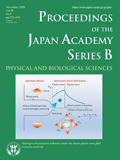About the Cover
Vol. 96 No. 9 (2020)
In the development of hydrogen energy utilization technologies such as fuel cell vehicles and hydrogen fueling station infrastructure, it is necessary to develop sophisticated technology for the prevention of hydrogen embrittlement. Moreover, owing to the difficulty in the experimental observation of hydrogen diffusion behaviors, it is essential to analyze the diffusion behaviors of hydrogen that flows into structures and concentrates under stress, which is related to hydrogen embrittlement.
Stress-induced hydrogen diffusion is a typical mechanism of hydrogen embrittlement and is elucidated by a model in which the lattice distance is expanded by the hydrostatic stress at the site of maximum hydrostatic stress, such as around a notch tip, caused by the existence of a site of hydrostatic stress concentration. The image on the cover illustrates the model of this mechanism. The governing equation for this model was previously proposed as a basic equation. However, at that time, non-numerical methods for deriving an analytical solution were proposed for special cases. Therefore, for applying this method to actual engineering problems, it is necessary to conduct a numerical analysis to adjust the various boundary and input conditions that arise in actual cases. In this type of numerical analysis, the contribution of the stress-induced hydrogen diffusion term in the governing equation was found not to be typical in its existing form. To solve this problem, the introduction of a coefficient α in the stress-driven term of the hydrogen diffusion equation, which actualizes the effect of stress on hydrogen diffusion behavior, that is, the α multiplication method, was proposed by Dr. A. Toshimitsu Yokobori, Jr. (this issue, pp. 373–393). Dr. Yokobori also proposed FEM–FDM, in which a stress analysis is conducted using the finite element method (FEM) and a hydrogen diffusion analysis is conducted using the finite difference method (FDM), as these methods are suitable for the respective analyses.
Based on these methods, a theoretical equation for predicting the site of hydrogen concentration and the sensitivity of hydrogen embrittlement in engineering structures was proposed for the first time. It should be noted that this is a mesoscale and macroscale analysis. Previous studies on the analysis of hydrogen diffusion were mainly concerned with clarifying the mechanism of hydrogen embrittlement, which is a microscale problem in materials science. The proposed method is distinguished from other methods by its focus on research for a responsible safety maintenance of hydrogen energy infrastructure.
Teruo Kishi
Professor Emeritus, The University of Tokyo




